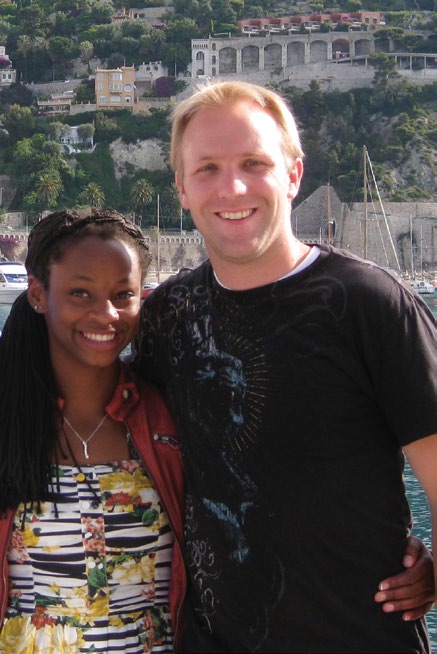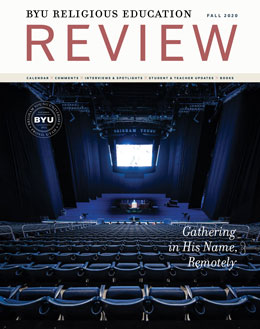Micah Shea, Joseph Smith, and (Social) Distance
Jordan T. Watkins
JORDAN T. WATKINS (jordan_watkins@byu.edu) IS AN ASSISTANT PROFESSOR OF CHURCH HISTORY AND DOCTRINE AT BYU.
During the current COVID-19 pandemic, we’ve become accustomed to hearing and using the term social distance. As an intellectual historian, I’ve spent a lot of time thinking about another kind of distance: historical distance. This is the dislocation that separates people across time rather than space. As a PhD student, I began to examine how antebellum Americans awoke to a sense of historical distance, or in other words, how they began to confront the realization that they lived in a cultural setting that was fundamentally different from past eras, including those they had approached as familiar. Just a few years after I began work on this topic, I was confronted by another kind of distance: the distance caused by death.
In 2012, Micah Shea, my youngest sibling, committed suicide. Once she had been brought close to me through adoption; now death has placed her at an unspeakable distance. During the past eight years, the personal distance between me and my sister has informed my scholarship on historical distance, and vice versa. And during the last few months, both have shaped how I’ve been thinking about social distancing. While practicing social distancing is different from the facts of isolation and social distance—whatever their causes and forms—perhaps it’s still worth making the obvious observation that to experience estrangement from each other is part of what it means to be human. Social distance reminds us of just how important our embodied interactions are; it imbues sociality with even greater meaning.
While we are in unique circumstances, peoples temporally distant from us have also faced and addressed challenges caused by isolation and social distance. Setting aside more obvious examples, Joseph Smith’s experiences during the summer of 1842—the time period covered in volume 10 of the Documents series of the Joseph Smith Papers—highlight the inspired ways in which the prophet of the Restoration dealt with the threat of social distance and the reality of isolation. Like the rest of us, he experienced various forms of social distance throughout his life. These distances inspired him; his revelations and teachings aimed to secure sociality. The sins Joseph committed when he was a boy led him to feel alienated from God and inspired him to seek and find communion with the divine. The events that followed can be understood as part of his quest to ensure an eternal communion for himself and, later, for the Latter-day Saints.
 Micah Shea Watkins, November 2011. Photo by Leah Watkins, used by permission
Micah Shea Watkins, November 2011. Photo by Leah Watkins, used by permission
That spiritual quest, and our comprehension of it, depends on material documents, mediations between people living in the same time and at different times. In the twenty-first century, our use of various forms of media can be understood as an effort to close the distances between us, even as those very uses can create new social distances. Similarly, we as historians use remainders from the past to bring close those who are historically distant, to varying effect. As we examine historical documents, the past moves in and out of focus, offering glimpses of its people and their problems. In the case of the summer of 1842, we discover that then, as now, media of all kinds mediated—by enhancing but also by mitigating and overcoming—social distance.
In July 1842, Missouri governor Thomas Reynolds issued a requisition, a document that demanded Illinois governor Thomas Carlin’s assistance in extraditing Joseph to Missouri for trial.[1] The trouble began on May 6, when an unknown assailant shot former Missouri governor Lilburn W. Boggs, who had signed the infamous “extermination order,” a document that promised to place distance between the Saints and their Missouri homes. After the May shooting, unsubstantiated rumors—which began to spread in Illinois newspapers—suggested that Joseph had orchestrated the assassination attempt.[2] During the same weeks, John C. Bennett became estranged from the Church.[3] These two developments soon converged in a new threat of extradition, which Bennett pledged to support.[4] Sensing danger, Joseph and the Saints petitioned Illinois governor Thomas Carlin for protection, and the Nauvoo City Council formed a new night watch and bolstered the municipal court’s power over habeas corpus cases.[5] When granted, a writ of habeas corpus demands that arrested persons be brought before a judge to determine the validity of the arresting warrant. In Joseph’s case, the writ would ensure that he could not be removed to Missouri without first being taken before a local justice of the peace. In other words, even as certain documents threatened to place distance between Joseph and his family, friends, and followers, other documents functioned to keep him close to them.
When Reynolds’s requisition reached Carlin, he signed an arrest warrant, and on August 8 three officers arrived in Nauvoo and arrested Joseph. Joseph immediately petitioned for a writ of habeas corpus, and Nauvoo’s municipal court obliged, temporarily separating Joseph from the officers and from the threat of removal to Missouri. Recognizing the limits of these legal safeguards, Joseph began to practice a kind of social distancing—he went into hiding. He chose to hide not in the face of a pandemic, but in hopes of avoiding an extradition attempt that posed a threat to himself and, he believed, to the Saints. While in hiding, he wrote to his wife Emma, explaining that it might be safer for him to be “at a little distance off.”[6]
 Micah Shea Watkins, November 2011. Photo by Leah Watkins, used by permission.
Micah Shea Watkins, November 2011. Photo by Leah Watkins, used by permission.
In relative isolation, as he contemplated further separation and even possible death, Joseph became reflective. On August 16, and a week later on the 23rd, while absent friends and family members—both dead and alive—Joseph spoke aloud their names for his secretary to record in the Book of the Law of the Lord. In this act the prophet brought loved ones close through memory, as well as through pen and ink. This was the creation of a medium that secured more than temporal safety. As Joseph noted, “These are the ones that shall inherit eternal life.”[7] Just a few weeks later, while again in hiding, he wrote to the Saints and instructed them to keep careful records of baptisms for the dead. Perhaps inspired by his recent petition for a writ of habeas corpus, he taught that records of rituals kept on earth would stand in for the dead in heaven, demanding that those without bodies be judged according to works done in the flesh.[8] In revealing the doctrine of baptism for the deceased, Joseph had found “a writ of H C [Habeas Corpus] & for the dead.”[9] Just as certain legal documents had power to protect against social distances on earth, certain ritual documents had power to mitigate spiritual and social distances in the eternities. Isolation from loved ones—and the threat of distance brought about by possible extradition and death—primed Joseph for revelation and inspired him to develop teachings and create documents aimed at securing sociality in heaven.
 Micah Shea Watkins and Jordan T. Watkins, May 2010. Courtesy of Jordan T. Watkins.
Micah Shea Watkins and Jordan T. Watkins, May 2010. Courtesy of Jordan T. Watkins.
Since Micah’s death—which created a distance of penetrating darkness and deep despair—I’ve pored over her journals in search of understanding and hope. Perhaps something like what led Joseph to insist on the importance of creating ritual records has led me to want to recover Micah’s writings; in light of her absence I want to secure her presence. This journey has placed me in close proximity to her successes and joys, but especially her sadness and pain. Although surrounded by a family that loved her immensely, she felt isolated and alone, the result of myriad realities, including her own choices and especially the choices of those who failed to see her light. These realities created distances that led to another kind of distance, one that no amount of documentation or creative readings of that documentation can seem to overcome.
But not all is lost. As I’ve tried to somehow close the imperceptible but omnipresent gap between myself and my youngest sister, I have gained a new awareness of separation, a new care for connection, and a new desire to respond to social distance with grace. I’ve also found increased hope in the records of Restoration rituals. Such records show that Micah and I were sealed together and that my mother received Micah’s initiatory and endowment on her behalf. These records signify that the distance between us need not be permanent. I continue to read Micah’s journals in hopes of discovering further evidence of the mitigating power of material documents. In one entry she noted, “It’s great having all of my siblings around at once.” Caring for such connections and expressing that care in pen and ink, as both Joseph and Micah Shea did, fills me with hope in Joseph’s teaching that the “same sociality which exists amongst us here will exist among us there only it will be coupled with eternal glory which we do not enjoy now.”[10]
Notes
[1] See Thomas Reynolds, Requisition, 22 July 1842, in Joseph Smith Papers, Journals, 2:380–81.
[2] See Letter to Sylvester Bartlett, 22 May 1842, in Joseph Smith Papers, Documents, 10:89–92 (this volume hereafter cited as JSP, D10).
[3] See Notice, 11 May 1842, and Letter to James Sloan, 17 May 1842, in JSP, D10:40–45, 69–71.
[4] See “Historical Introduction” to Letter from Calvin A. Warren, 13 July 1842, in JSP, D10:257–58.
[5] See Mayor’s Order to City Watch, 20 May 1842, in JSP, D10:82–84; Letter to Thomas Carlin, 24 June 1842, JSP, D10:195–200; Ordinance, 5 July 1842, JSP, D10:233–36; Letter from Thomas Carlin, 27 July 1842, in JSP, D10:314–17; and Letter to Thomas Carlin, 30 July 1842, in JSP, D10:323–24.
[6] Letter to Emma Smith, 16 August 1842, in JSP, D10:402.
[7] See Reflections and Blessings, 16 and 23 August 1842, in JSP, D10:414–25, quotation on 418.
[8] See Letter to “All the Saints in Nauvoo,” 1 September 1842 [D&C 127], pp. [1–3], www.josephsmithpapers.org; and Letter to the Church, 7 September 1842 [D&C 128], pp. [1–9], www.josephsmithpapers.org.
[9] Minutes and Discourses, 6–9 April 1844, as reported by Thomas Bullock, p. 27, www.josephsmithpapers.org.
[10] Instruction, 2 April 1843, as reported by William Clayton, p. 67, www.josephsmithpapers.org.
